Dill
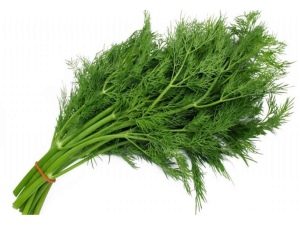
Dill (Anethum graveolens) belongs to the Umbelliferae family. Dill in German is called Gurkenkraut, Gurkenkümmel, Blahkraut, Kapernkraut, in English - dill, in French - aneth odorant.

Appearance
Dill is an annual herb with a straight, branched stem. The stem is dark green. The pinnate leaves are blue-green in color, reach a length of up to 0.2 m. Dill itself can grow in height from 0.4 m to one and a half meters.
The flowers are collected in inflorescences, similar to umbrellas, and are painted yellow. In diameter, these inflorescences can reach up to 0.2 m.
Dill seeds are oval or elliptical in shape, up to 0.5 cm long and only a few millimeters thick.



Kinds
Dill has a single species, called fragrant dill (or garden dill).

Where does it grow
The countries of the Mediterranean Sea and Western Asia are considered the homeland of dill. There are suggestions that it was grown in ancient states. For example, the inhabitants of Ancient Greece and Ancient Rome already cultivated dill. In the Middle Ages, he migrated to the countries of Central Europe, from where he gradually left for Scandinavia and the northern countries.
Dill is also common in Russia, growing both in temperate and southern latitudes.In the wild, it can be found in Asian countries, while in Russia this plant is cultivated in almost any garden.
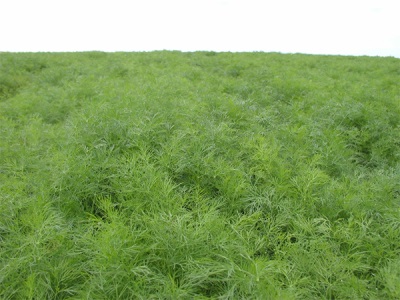
spice making method
Fresh or dried and crushed dill leaves are used as a spice. Dill flowers or fruits are also sometimes used, for example, for canning or the production of vinegar.



How and where to choose a spice?
Dried dill, along with fresh, can be found in any supermarket or market, as well as in a spice store. You should pay attention to the color of the plant: it should be intense green, without yellowness. This suggests that the dill did not grow in favorable conditions for it. This feature applies to the plant not only fresh, but also in the form of spices. When choosing seeds, you should also pay attention to their color. Bright and fragrant seeds speak of their freshness. The longer they sit, the duller they become, not to mention the loss of smell.


Peculiarities
Dill has delicate carved leaves. Its yellow inflorescences are formed only in the summer season, their taste is more intense. Due to its bright and characteristic taste, dill is far from suitable for all seasonings and herbs.
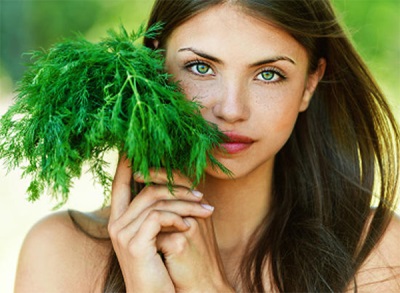
Characteristics
Dill has the following characteristics:
- has a bright refreshing aroma and taste;
- is one of the most popular seasonings;
- used for medical purposes;
- actively used in the alcohol industry.
You can learn more about the properties of dill from an excerpt from the program "Live healthy!".
Nutritional value and calories
100 grams of fresh dill contains 40 kcal.
The nutritional value of the product is as follows:
- proteins - 2.5 g;
- fats - 0.5 g;
- carbohydrates - 6.3 g;
- dietary fiber - 2.8 g;
- organic acids - 0.1 g;
- water - 85.5 g;
- unsaturated fatty acids - 0.1 g;
- monosaccharides and disaccharides - 6.2 g;
- starch - 0.1 g;
- ash - 2.3 g;
- saturated fatty acids - 0.1 g.
Chemical composition
The chemical composition of 100 grams of dill contains the following components:
- vitamins: PP - 0.6 mg; β-carotene - 4.5 mg; A - 750 mcg; B1 (thiamine) - 0.03 mg; B2 (riboflavin) - 0.1 mg; B5 (pantothenic) - 0.3 mg; B6 (pyridoxine) - 0.2 mg; B9 (folic) - 27 mcg; C - 100 mg; E - 1.7 mg; RR (niacin equivalent) - 1.4 mg;
- macronutrients: calcium - 223 mg; magnesium - 70 mg; sodium - 43 mg; potassium - 335 mg; phosphorus - 93 mg;
- trace elements: iron - 1.6 mg; zinc - 0.91 mg; copper - 146 mcg; manganese - 1.264 mg.
Dill contains a large amount of flavanoids and pectins. All its parts contain essential oils, due to which its specific aroma appears. The fruits have the highest content of essential oils.

Beneficial features
The list of useful properties of dill is impressive:
- used in traditional and alternative medicine;
- serves as an antioxidant;
- has disinfecting properties;
- helps to eliminate itching;
- relieves eye fatigue;
- calms the nervous system.

Harm
With the frequent use of dill in large volumes, the following consequences are possible:
- weakness;
- loss of visual acuity;
- dizziness.
Contraindications
It is not recommended to use dill in any form in the following cases:
- with hypotension (low pressure);
- with personal intolerance to the plant.
Pregnant women should also use dill with caution.
Oil
Dill oil is usually obtained from its seeds or stems with leaves by steam distillation. The initial material should be in a slightly dried form. Dill oil has no color, if only a slight yellowish tinge, and is completely transparent.The smell is dominated by fresh notes with an admixture of spicy and sweet aroma. The aroma of dill oil is similar to cumin. The smell of dill is preserved in the oil that is obtained from the leaves.
Dill oil has a sedative effect, helps relieve stress, relieve pain and spasms. It is an excellent assistant in the fight against diseases of the digestive tract. It is also used to normalize the activity of the heart and blood vessels.
Sometimes dill oil is used to treat skin diseases and is added to cosmetics to care for dry skin. Occasionally, it is present in preparations used in dentistry.

Juice
Dill juice, taken along with parsley juice, helps to make freckles lighter. In addition, dill juice helps to get rid of unwanted spots on the skin.
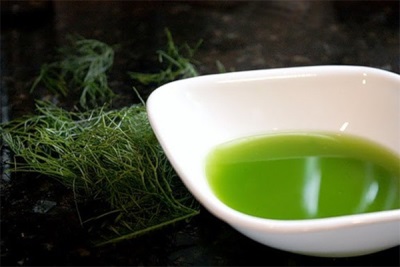
Application
In cooking
Dill, both fresh and dried, is actively used in cooking. The scope of its use is extensive:
- seasoning in European fish dishes;
- a frequent ingredient in brines;
- used in canning (especially for cucumbers);
- fresh is added to salads at the final stage of preparation;
- added to egg and vegetable dishes;
- used in sauces;
- participates in the preparation of vinegar;
- added to spices and spices;
- serves as a condiment for cold and hot dishes.
Dill makes an excellent combination with parsley. To add the plant to dishes in the cold season, it is better to freeze dill, since in dried form it already has practically no flavor.
Due to the high content of phytoncides, vegetables canned with the addition of dill not only have a richer taste, but also acquire protection against fungus and mold.
Dill fruits and leaves are also used to give a special flavor to pastries, sauerkraut, and tea.
Fresh dill should not be heat-treated, as it immediately loses all smell and taste. It is best to add it to hot dishes already at the end of cooking or before serving.

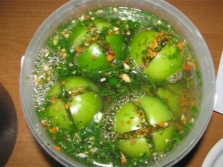

Preparation for the winter
From dill, you can make winter harvesting according to the following recipe:
- you will need 0.5 kg of dill and salt;
- dill is washed, dried and chopped;
- then it is mixed with salt in a ratio of 2:1;
- dill is placed in sterilized jars, closed and stored in the cold.

Seasoning
The plant can also be used to make an excellent condiment. For this:
- take a tablespoon of salt, a couple of tablespoons of vegetable oil, 500 ml of white wine vinegar and a kilogram of dill;
- dill is coarsely chopped (the stems are cut smaller than the leaves) and placed in sterilized jars;
- in a separate container, boil one and a half glasses of water with the addition of salt and vinegar, then the water is cooled;
- dill is poured with the resulting marinade;
- almost ready mixture should be infused for 8 hours, after which it is poured with oil;
- jars are closed and stored in the refrigerator.
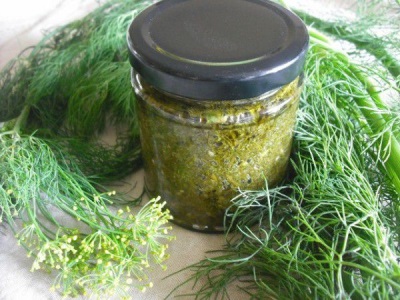
In medicine
The medicinal properties of dill have long been known. It is used in the following cases:
- to improve the functioning of the digestive tract;
- at elevated pressure;
- to improve the functioning of the cardiovascular system;
- for the treatment of cystitis and kidney disease;
- as a diuretic;
- to increase lactation;
- for the treatment of headaches;
- to eliminate insomnia and neurosis;
- with problems with the respiratory system;
- as an anesthetic for diseases of the gastrointestinal tract;
- to increase appetite;
- to eliminate allergies on the skin;
- in the treatment of hemorrhoids.
Infusion recipe
1 st. l. grind dill seeds in a blender, pour 200 ml. boiling water. Cover with a towel and leave for 20 minutes. Strain the infusion through cheesecloth.
Application:
- For cystitis, urethritis and other diseases of the urinary tract, drink an infusion of 40 ml. 6 times a day.
- As an anti-inflammatory, expectorant or sedative, use 1 tbsp. l. infusion 15 minutes before each meal.
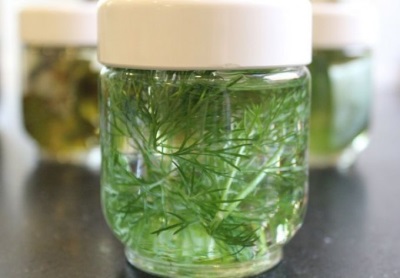
With gum disease, stomatitis
For 1 liter steep boiling water, take 100 gr. dill seeds. Insist 10 minutes. Try to keep the mixture in your mouth for 30 seconds.
For acne, pimples
To 1/2 tbsp. chamomile flowers add 1/2 tbsp. dill seeds, pour 100 ml. boiling water and boil for 5 minutes. Strain, cool and moisten problem areas with a cotton swab several times a day.
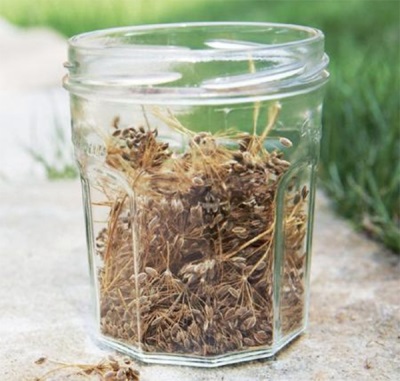
From night blindness
In the juice of 1 carrot, add the juice from a bunch of dill in a ratio of 5 to 1. Drink 200 ml. juice received every day for a month.
Oil
Dill oil is also used effectively as an expectorant. Dill seed tincture stimulates appetite and restores normal sleep.
Modern medicine uses dill to produce anetine, which has a beneficial effect on the functioning of the heart and blood vessels. Dill oil is sometimes used in aromatherapy to relieve fatigue and combat stress.
When losing weight
Dill is indispensable for weight loss. Possessing a diuretic effect, it is able to eliminate edema and remove excess fluid from the body. In addition, it improves bowel function, helps to remove toxins from the body. For weight loss, a decoction of dill is usually used, which is taken in limited quantities before meals (it is desirable that the volume of the decoction for each dose does not exceed 100 ml).

At home
Household uses of dill are as follows:
- used in medicine;
- used in cooking;
- is one of the ingredients of some alcoholic beverages;
- used in cosmetics;
- occasionally used in fragrances and perfumes;
- dill oil is even used in soap making.


cultivation
Dill tolerates cold and has a fairly short vegetative period, so it can be planted even more than once during the summer period.
Dill seeds are formed at an average daily duration of more than 12 hours. It is best grown in full sun, although partial shade is acceptable. The acidity and moisture of the soil should be moderate, otherwise the dill will be prone to yellowing.
Water the plant at least a couple of times a week. Of course, it tolerates drought quite calmly, but with regular watering, the yield will be much higher. You can occasionally fertilize dill, but do not experiment with a large amount of nitrogen fertilizers.
It is not recommended to grow dill where parsley or celery previously grew.
You can plant seeds in the second half of April or early May, depending on the soil. It is better to keep a distance of at least 0.2 m between rows. The planting depth of dill seeds should not exceed a couple of centimeters.
The plant does not require excessive care, but it needs periodic weeding and watering in strong sunshine.
You can even grow dill at home on the windowsill.

See below for details.
Interesting Facts
- The ancient Romans decorated their homes with dill, and the Greeks included it in medicinal infusions.
- The aroma of dill tends to interrupt the smells of other spices, so you should combine it with them very carefully.
- The first mention of dill was in the scrolls of Ancient Egypt.
- Dill wreaths were often worn on the head in ancient times as a sign of victory and honor.
- In Byzantium, the first mention of dill appeared in the tenth century, where there was already information about its medicinal benefits.


















I love dill! I even dry it for the winter to add to dishes. In dried form, I think it is much more aromatic.
I love the smell of dill. Especially when you rub the young leaves between your fingers! At the mother-in-law in the garden grew by itself.